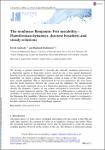The nonlinear Benjamin–Feir instability – Hamiltonian dynamics, discrete breathers and steady solutions
| dc.contributor.author | Andrade, D | |
| dc.contributor.author | Stuhlmeier, R | |
| dc.date.accessioned | 2023-03-20T11:52:49Z | |
| dc.date.available | 2023-03-20T11:52:49Z | |
| dc.date.issued | 2023-03-10 | |
| dc.identifier.issn | 0022-1120 | |
| dc.identifier.issn | 1469-7645 | |
| dc.identifier.other | A17 | |
| dc.identifier.uri | https://pearl.plymouth.ac.uk/handle/10026.1/20594 | |
| dc.description.abstract |
<jats:p>We develop a general framework to describe the cubically nonlinear interaction of a degenerate quartet of deep-water gravity waves in one or two spatial dimensions. Starting from the discretised Zakharov equation, and thus without restriction on spectral bandwidth, we derive a planar Hamiltonian system in terms of the dynamic phase and a modal amplitude. This is characterised by two free parameters: the wave action and the mode separation between the carrier and the sidebands. For unidirectional waves, the mode separation serves as a bifurcation parameter, which allows us to fully classify the dynamics. Centres of our system correspond to non-trivial, steady-state nearly resonant degenerate quartets. The existence of saddle-points is connected to the instability of uniform and bichromatic wave trains, generalising the classical picture of the Benjamin–Feir instability. Moreover, heteroclinic orbits are found to correspond to discrete, three-mode breather solutions, including an analogue of the famed Akhmediev breather solution of the nonlinear Schrödinger equation.</jats:p> | |
| dc.format.extent | a17- | |
| dc.language | en | |
| dc.publisher | Cambridge University Press (CUP) | |
| dc.subject | surface gravity waves | |
| dc.title | The nonlinear Benjamin–Feir instability – Hamiltonian dynamics, discrete breathers and steady solutions | |
| dc.type | journal-article | |
| dc.type | Article | |
| plymouth.author-url | https://www.webofscience.com/api/gateway?GWVersion=2&SrcApp=PARTNER_APP&SrcAuth=LinksAMR&KeyUT=WOS:000941395600001&DestLinkType=FullRecord&DestApp=ALL_WOS&UsrCustomerID=11bb513d99f797142bcfeffcc58ea008 | |
| plymouth.volume | 958 | |
| plymouth.publication-status | Published | |
| plymouth.journal | Journal of Fluid Mechanics | |
| dc.identifier.doi | 10.1017/jfm.2023.96 | |
| plymouth.organisational-group | |Plymouth | |
| plymouth.organisational-group | |Plymouth|Faculty of Science and Engineering | |
| plymouth.organisational-group | |Plymouth|Faculty of Science and Engineering|School of Engineering, Computing and Mathematics | |
| plymouth.organisational-group | |Plymouth|REF 2021 Researchers by UoA | |
| plymouth.organisational-group | |Plymouth|Users by role | |
| plymouth.organisational-group | |Plymouth|Users by role|Academics | |
| plymouth.organisational-group | |Plymouth|REF 2021 Researchers by UoA|UoA10 Mathematical Sciences | |
| plymouth.organisational-group | |Plymouth|REF 2021 Researchers by UoA|EXTENDED UoA 10 - Mathematical Sciences | |
| plymouth.organisational-group | |Plymouth|Users by role|Researchers in ResearchFish submission | |
| dcterms.dateAccepted | 2023-01-26 | |
| dc.date.updated | 2023-03-20T11:52:47Z | |
| dc.rights.embargodate | 2023-3-21 | |
| dc.identifier.eissn | 1469-7645 | |
| dc.rights.embargoperiod | 2023-03-21 | |
| rioxxterms.versionofrecord | 10.1017/jfm.2023.96 |


